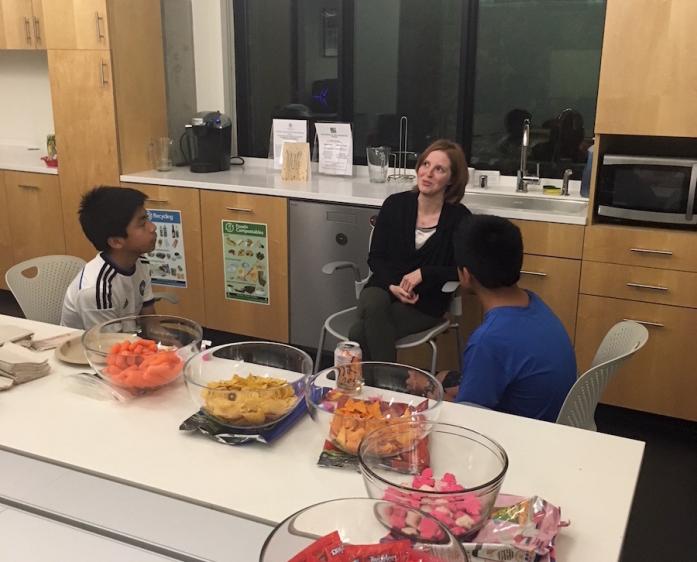
Photo: Alainna Brown, MD/PhD student in the Graduate Program in Neuroscience, talks about deep brain stimulation
Earlier in November, the Center for Sensorimotor Neural Engineering (CSNE)'s Student Leadership Council held an outreach workshop geared towards helping scientists, graduate students, and post-docs to communicate their area of science research to someone unfamiliar with the field. Children of different ages listened to scientists talk about their research, and then they asked follow-up questions and provided feedback about the explanation.
"Only 1 in 5 Americans have met a scientist. Think about that," says Kaitlyn Casimo, student coordinator for outreach and education at CSNE and a fifth-year doctoral student in the UW Graduate Program in Neuroscience and affiliate of the UW Integrated Brain Imaging Center (IBIC), who planned this event. “The science profession has an image problem. Kids should be able to imagine themselves as researchers and have role models in science because science is everywhere—it's applicable to everyone's life and medical decisions."

Kaitlyn Casimo, UW Graduate Program in Neuroscience. Photo by Marcus Donner
Despite blustery fall weather, the event drew a group of 1st and 3rd graders ready to help professional scientists communicate their research at different levels of complexity. “I'm glad we had participants of different ages," said Casimo. "It’s fun not just to know—but to really experience—what a 5-year old vs. a 12-year old vs. a 30-year old can understand.”
Harkirat Sohi, Ph.D. student in UW Biomedical & Health Informatics, sat down with 3rd graders Ben and Gabe and took on the challenge of explaining her research in the field of Alzheimer's disease. She hopes to contribute to a better understanding of the different kinds of impairments in Alzheimer's disease, focusing on primary impairments in memory, language, executive function and visuospatial capabilities, which have been identified in patients through clinical cognitive tests. Using machine learning algorithms on neuroimaging data from Alzheimer's disease patients, she seeks to identify brain regions that are important for classifying patients into different impairment groups within Alzheimer's Disease. She told Ben and Gabe that this approach would allow for a better understanding of the disease and the brain functions and regions associated with the subgroups, and hopefully lead to a more targeted drug design.
"These students didn’t know anything about Alzheimer's disease at the beginning of our conversation," said Sohi, "but all that mattered was their curiosity and desire to ask questions." Ben and Gabe asked about where the name Alzheimer's came from. They asked why cases of Alzheimer's disease are rising in America and how to prevent dementia.
The kids learned a great deal about brain-related research at the event. For example, David Caldwell, an M.D./Ph.D student in Bioengineering explained his work in neural connectivity and his ultimate goal of creating neural implants to restore movement to people with neurological injury. Alainna Brown, MD/PhD student in the Graduate Program in Neuroscience who conducts her work in the UW Integrated Brain Imaging Center, spoke about the benefits of deep brain stimulation for Parkinson's disease.
"One of the most gratifying interactions I had was with a future scientist who was about seven years old," said Brown. "His eyes just about popped out of his head as he intuited a number of things about what deep brain stimulators can do for people with Parkinson's disease. He said 'What if someone's legs shook too much so they couldn't even walk? Then this could—make them ABLE TO WALK!"
Brown enjoyed this event not only because it challenged her to distill her work down to fundamentals, but also because it got her communicate her work in a way that sent her "mental wheels spinning." To her, mastering the ability to communicate science allows one to represent the importance of a research area to different audiences.
"Science and engineering have a wide range of stakeholders—patients, families, policymakers, students, investors, scientific colleagues—who in turn have an equally wide range of professional backgrounds and personal experiences that influence how each interprets the potential of and details of the work we do," Brown said. "In my opinion, the ability to get a sense of a person's background and communicate about one's work effectively based on that understanding is a crucial part of any scientific endeavor."
Kaitlyn Casimo has taken this science outreach effort by storm. In her role at the CSNE, she is training student volunteers to do public outreach on behalf of the CSNE. In workshops she is leading during the 2017–18 academic year, these CSNE-affiliated students will learn how to clearly and concisely explain their research and create educational outreach resources. For example, in the winter quarter, Casimo plans to have a four-month sequence where people will get to build an interactive activity that demonstrates a concept of neural engineering, such as spinal stimulation or the process of recording neural signals from the brain's motor cortex.
Recently, Casimo created a self-paced online course, Introduction to Neural Engineering, which is now available to educators through the CSNE website.
- Read more about Kaitlyn Casimo's research in brain connectivity and outreach efforts in this article from CSNE: UW grad student makes neural engineering understandable and accessible
- Frankenstein: A modern postmortem - the UW Daily covered Kaitlyn Casimo's recent outreach event at the Pacific Science Center
The next CSNE Communication and Outreach event will happen at the CSNE on December 5th. In the Ten Hundred Words competition, participants will explain their research using only the ten hundred most common words in the English language. The judges will evaluate the clarity of each explanation, how well the simplified and technical explanations complement each other, and delivery. The event is open to students and staff in the areas of neural engineering, computational neuroscience, disease and injury neuroscience, and related fields. Register here and learn more about the inspiration for this competition in Scientific American's Science in Ten Hundred Words: The `Up-Goer Five' challenge. —Genevieve Wanucha





